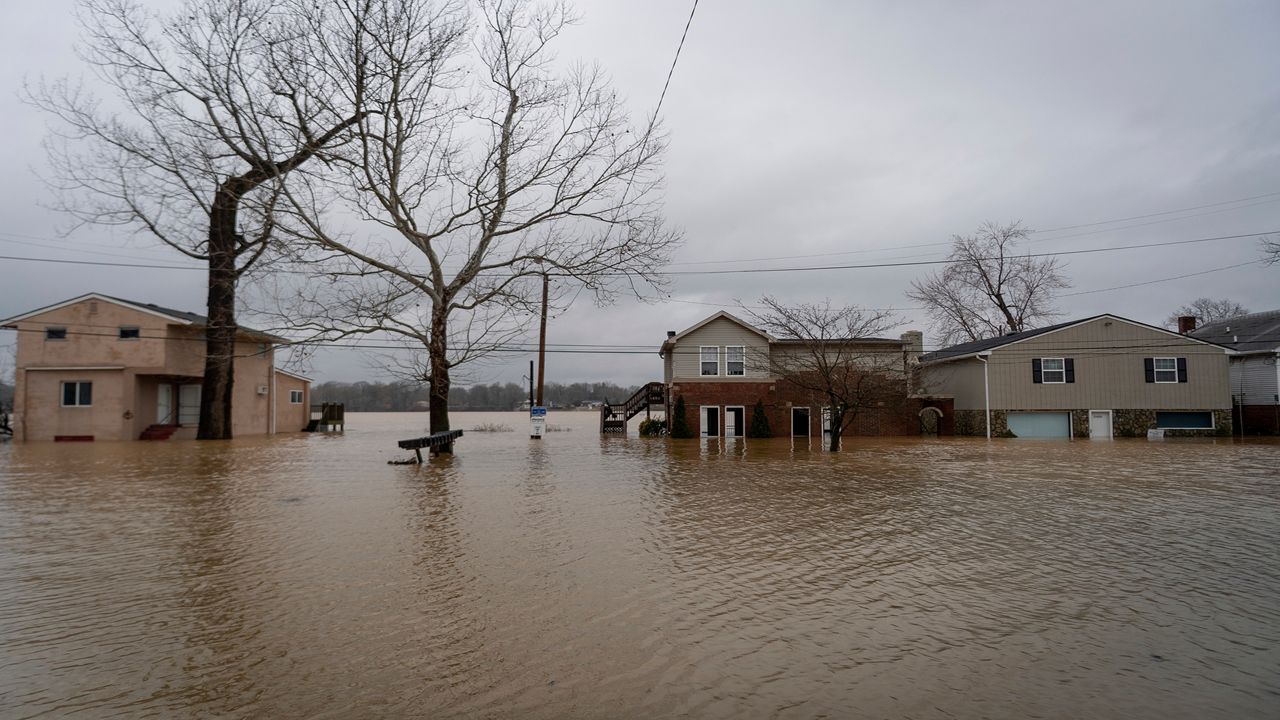LOUISVILLE, Ky. — Last February, six inches of rain fell on eight southeastern Kentucky counties, burying dozens of roads beneath icy, brown flood waters and sweeping two mobile homes down the Cumberland River. In March, Paducah was pelted with golf ball-sized hail. April saw severe storms knock out the power to 57,000 eastern Kentucky homes. And May brought central Kentucky flash flooding that required Lexington firefighters to make multiple water rescues.
Like much of the last decade, 2020 was an exceedingly wet year in the commonwealth, with a statewide average of 57.9 inches of rainfall, according to the National Oceanic and Atmospheric Administration (NOAA). That was good for the eighth-highest amount of precipitation in the last 126 years. Since 1895, average annual Kentucky rainfall has eclipsed 57 inches only 10 time. Five of those years have come in the last decade, including 2019 (the state’s fifth wettest year), 2018 (its second wettest), 2015 (the seventh wettest), and 2011 (the wettest ever).
This is what climate change looks like in Kentucky, a state where temperature changes over the past century have been modest but severe and unpredictable weather events have spiked.
“It's a more complicated set of changes than just warming,” said Jeff Dukes, director of the Purdue Climate Change Research Center. “It's the amount of precipitation. It's the timing of precipitation. It’s rain when you got snow before. There are a lot of different things involved. It’s why I think the better term is 'climate disruption,' because we're disrupting the stable climate that we've had for thousands of years.”
For years, experts and reports from the U.S. government have identified increased rainfall and more frequent severe weather events as one of the primary results of a changing climate in the commonwealth. And for years, both have become more common, according to NOAA’s National Centers for Environmental Information.
In 2020, five of the climate sites monitored by Spectrum News 1 saw higher-than-average rainfall amounts. Jackson, in eastern Kentucky, led the way with 13 more inches of precipitation than average. Louisville saw eight more inches than average, Covington five more inches, Bowling Green four-and-a-half more inches, and Lexington 2.3 more inches.
“As impressive as the numbers were in 2020, 2019 was actually a lot wetter,” Spectrum News 1 Chief Meteorologist Wes Callison said. Two years ago, Bowling Green’s rainfall was 12 inches above average, Lexington’s was 11 inches above average, and Covington’s was 10 inches above average.
The weather has also become more variable, said Steven McNulty, Director of the USDA Southeast Regional Climate Hub. “You might see two weeks without rain followed by two or three inches of rain and another couple of weeks without rain,” he said.
In the past few years, the southeastern part of the U.S. has seen a 27% increase in what McNulty calls “extreme events,” which occur when more than two inches of precipitation fall in a 24-hour period.
Rainfall on that scale can overwhelm small towns, particularly in the hills of eastern Kentucky. “When you get a big rain event, it drains off of the hills and drains into the valley bottoms,” McNulty said. “The topography of Kentucky is such that it lends itself to increase flooding from these types of flash events.”
While it’s not possible to blame any single storm, drought, or flood on the overall trends of climate change, Dukes said, “you can say it was probably made worse because of climate change and that was certainly made more likely because of climate change.”
Torrential downpours and flash flooding have immediate and obvious effects on the communities where they happen. They may create inconveniences by blocking roads, or lead to tragedies, as was the case last April when a flash flood in Bath County led to the death of five Amish children in a horse-drawn buggy.
But they also have long term effects. “What Climate Change Means for Kentucky,” a 2016 document from the Environmental Protection Agency, said warming temperatures and increased rainfall can harm aquatic ecosystems and reduce crop yields. In 2017, the U.S. Army Corps of Engineers warned that climate change-driven flooding could damage essential transportation infrastructure, including roadways and bridges.
Dukes warned of damage to the ecological systems of streams and rivers, along with the potential for floods to dump sediment on farmland. Counterintuitively, despite the increased precipitation, drought conditions are also increasing as the period between rainfall grows longer and the warm atmosphere causes increased evaporation.
Lexington provided an example of that volitility in 2019. “Lexington didn’t see more than a trace of rain on any day from Aug. 28 through Oct. 5, and they still ended up 11 inches above normal for the year of 2019,” Callison said. “That’s pretty impressive.”
As the climate continues to change, Dukes said Kentucky can look forward to more of the same. “We expect to see conditions continue to get wetter, particularly in winter and spring, and we expect heavier downpours that erode soil and cause flooding,” he said.
Eventually, the commonwealth is likely to experience the same type of warming other areas of the world have. “A lot of climate models suggest that the warming that’s happening globally is going to accelerate in the Midwest and in Kentucky,” Dukes said. “That warming is going to happen quickly and the number of days on which there's a heat wave or dangerously high heat index could easily triple or quadruple with relatively high emissions.”



